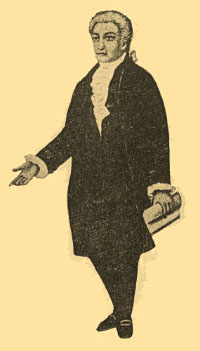THE PRINCE OF BLACK FREEMASONRY By PM Charles W. Sharpe
American patriot, biblical student, abolitionist, educator and craftsman, Prince Hall was founder and first Grand Master of black Freemasonry. He was the first of a long line of revered black political and social organizers to have a lasting impact on American society and its history.
Prince Hall was born September 14, 1735, and died on December 4, 1807. Surprisingly, other supporting documentation or evidence of proof about the personal life of this remarkable man is sketchy. Even Past Grand Master William H. Grimshaw's account of Hall's parentage, place of birth and other personal history has now been discounted by many scholars.
Most researchers agree It is probable that Prince Hall was reared somewhere within the British Empire and migrated to America. His reference to "home" in a letter to the Countess of Huntington and his friendship with other British nobility would suggest he had strong roots among the English upperclass. Yet some Masonic historians disagree. They insist that Prince Hall was a slave as evidenced by a manumission paper filed for a "Prince Hall" by slave owner William Hall on April 9, 1770. This took place one month after the first shot of the American Revolution killed Michael Johnson whom we now know as Crispus Attucks.
Fortunately, The Masonic credentials of Prince Hall and the regularity of the black Masonic Lodges which affiliated themselves by his name are beyond dispute. On March 6, 1775, over a year before the signing of the Declaration of Independence, Prince Hall and 14 other free black men were made Master Masons in Army Lodge No. 441 by Worshipful Master John Batt working under the authority and the Constitution of the Grand Lodge of Ireland. When the British Regiments left Boston on March 17, 1776, a Dispensation was issued by Batt authorizing Prince Hall and his brethren to meet as a Lodge under restrictions. Under this permit, African Lodge No. 1 was formed July 3, 1776.
Official acknowledgement of the legitimacy of African Lodge No.1 was almost immediately made by John Rowe of Boston, a caucasian and provincial Grand Master for North America holding authority from the premier Grand Lodge of Freemasons, the Grand Lodge of England. He, too, issued a permit authorizing African Lodge No. 1 to appear publicly in procession as a Masonic body for the purpose of celebrating the Feast of Saints John and to bury its dead.
For nine years these brethren, with other free black men who had received their degrees in Europe, assembled together and enjoyed their limited privileges as Masons, distressed that Prince Hall's attempts to formally associate African Lodge with Caucasian (Provincial) Grand Lodges were frustrated by bigotry and racism. It was an ironic period in American history when colonists embraced the doctrine of independence, liberty, and equality to justify the revolt against English rule while promoting and condoning the economic and social exploitation of blacks debased by slavery.
Finally, in March, 1784, Prince Hall petitioned the Grand Lodge of England through Worshipful Master William Moody of Brotherly Love Lodge No. 55 (London, England) for a Warrant of Constitution. The Charter was prepared and issued on September 29, 1784, although it would be three years before African Lodge actually received it.
A letter was sent by Moddy to Hall on March 10, 1787, stating the Charter was delivered to James Scott, Captain of the ship, Neptune, and brother-in-law of John Hancock. Hancock was a signer and President of the Continental Congress. The Charter, signed by Deputy Grand Master Roland Holt and witnessed by Grand Secretary William White, reconstituted African Lodge No. 1 as African Lodge No 459 and thus began the parallel lines of black and Caucasian Freemasonry which continues to exist in America.
Before 1815, exclusive territorial jurisdiction was not an active and recognized doctrine of English Masonic Custom. The African Lodge of Boston exercised its right to establish other Lodges, making itself a Mother Lodge, its Master Prince having the authority to issue warrants on the same basis as Masters of Lodges in Europe!
African Lodges were constituted in Pennsylvania, Rhode Island, and New York. On June 24, 1791, the African Grand Lodge of North America was organized in Boston with Prince Hall as Grand Master. This was one year before the organization of the United Grand Lodge of Massachusetts (Caucasian). In 1827, 45 years after the (Caucasian) Grand Lodge of Massachusetts had done so, African Lodge of Boston declared itself independent of the Grand Lodge of England.
The original charter of African Lodge of Boston is in the possession of the Most Worshipful Prince Hall Grand Lodge of Massachusetts and is the only known original 18th Century Charter in existence issued to any American Lodge by the Grand Lodge of England. It proudly represents the indisputable legitimacy and regularity of 45 Prince Hall Grand Lodges and their subordinate lodges and affiliated bodies.
In 1869 a fire destroyed Massachussets' Grand Lodge headquarters and a number of its priceless records. The Charter, in its metal tube, was in a Grand Lodge chest. The tube saved the Charter from the flames but the intense heat charred it. The Charter was saved when Grand Master S.T. Kendall crawled into the burning building and saved the Charter from complete destruction. Thus a Grand Master's devotion and heroism further consecrated this parchment to us, and added a further detail to its history.
During 1947, in memory of Prince Hall, the descendent Grand Lodges of African Grand Lodge changed their names to "Prince Hall Grand Lodge" with two exceptions. Today, throughout the world, there are 43 "Most Worshipful Prince Hall Grand Lodges", some 5000 subordinate Lodges and more than 300,000 Prince Hall Masons.
![]()

